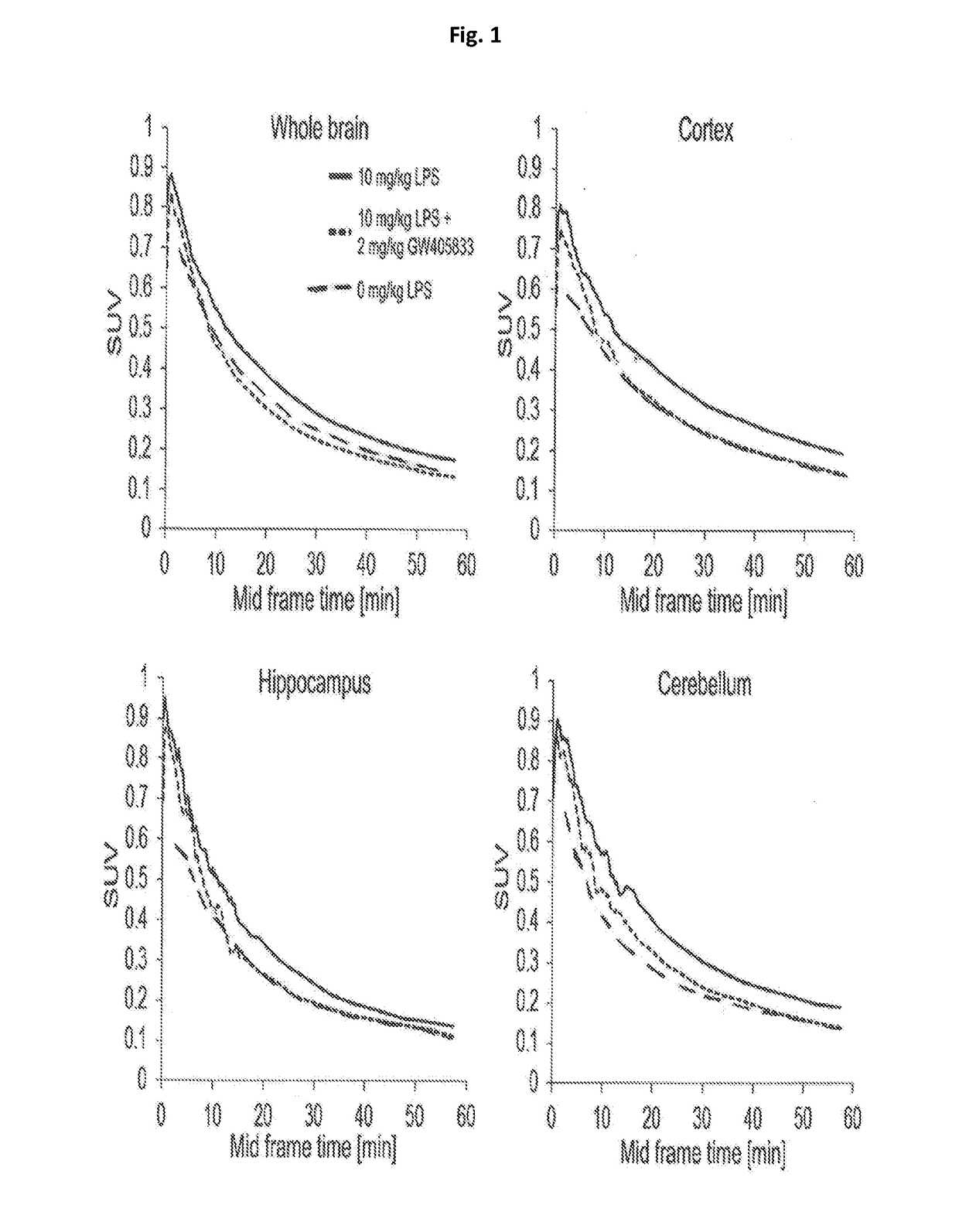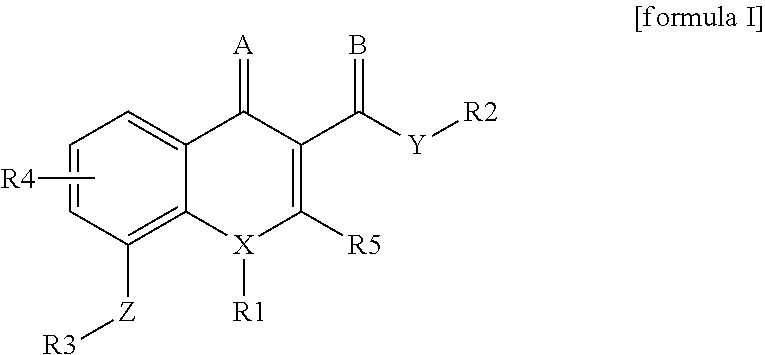4-oxo-1, 4-dihydroquinoline-3-carboxamide as selective ligand for cannabinoid receptor 2 for diagnosis and therapy
a cannabinoid receptor and selective ligand technology, applied in the direction of drug composition, organic chemistry, nervous disorders, etc., can solve the problems of unsatisfactory effects, uncovered remarkable complexity of ecs, and observed relatively high plasma binding of lipophilic pet tracer, and proved not to be favorable for brain imaging
- Summary
- Abstract
- Description
- Claims
- Application Information
AI Technical Summary
Benefits of technology
Problems solved by technology
Method used
Image
Examples
example 1
of Compounds
[0101]The synthesis of the compounds with the general structure of formula I can, for example, be accomplished according to the following schemes.
Synthesis of diethyl 2-(((2-methoxyphenyl)amino)methylene)malonate (1)
[0102]To 2-anisidine (6.36 g, 51.6 mmol) was added diethyl 2-(ethoxymethylene)malonate (11.17 g, 51.6 mmol). The mixture was stirred and heated in an oil bath to 110° C. and stirred 1 h. After cooling to rt, the crude mixture was recrystallized from hexane (50 mL) to give 1 in a yield of 88%. HRMS calcd for C15H19NNaO5 316.1155, found 316.1164.
Synthesis of ethyl 8-methoxy-4-oxo-1,4-dihydroquinoline-3-carboxylate (2)
[0103]To 1 (13.00 g, 44.3 mmol) was added diphenylether (70 mL). The reaction mixture was heated to 250° C. for 1 h. After cooling to rt, the mixture was filtrated and the precipitates washed with diphenylether (10 mL) and hexane (3×10 mL). After recrystallization from ethanol (150 mL), the precipitates were collected by filtration and dried under ...
example 2
Binding Assay
[0124]The following test was carried out in order to determine the binding affinity of the compounds of formula I towards CB2 and CB1:
[0125]Competitive binding reactions were initiated by the addition of a membrane preparation obtained from CHO-K1 cells stably transfected with human CB1 and CB2, respectively, from PerkinElmer (0.5 pig / tube for hCB1 and hCB2) into incubation tubes. As displacer, 1.4 nM [3H]CP55,940 (PerkinElmer) was used and 6 to 10 concentrations (ranging from 1 pM to 10 μM) of displacing ligand (compound to test) in assay buffer (50 mM TRIS, 1 mM EDTA, 3 mM MgCl2 and 0.05% bovine serum albumin, pH adjusted to 7.4) were added. Nonspecific binding was defined by the presence of 5 μM WIN-55212-2. After incubation at 30° C. for 90 min reactions were terminated by the addition of 3 mL ice cold assay buffer followed by rapid vacuum filtration through a Whatman GF / C filter (pre-soaked for 2 h in 0.05% polyethylenimine in water) and washed twice with 3 mL ice ...
example 3
lling of Compounds for PET Imaging
[0127]
[0128][11C]CO2 was produced via the 14N(p, α)11C nuclear reaction by bombardment of nitrogen gas fortified with 0.5% oxygen using a Cyclone 18 / 9 cyclotron (18-MeV; IBA, Belgium). After reduction over a supported nickel catalyst to [11C]CH4 and subsequent gas phase iodination, [11C]CH3I was bubbled through a mixture of precursor 6 (1 mg) and cesium carbonate (5 mg) in DMF (0.6 mL). The mixture was heated to 90° C. for 3 min. After dilution with water (1.4 mL), the crude product was purified using semi-preparative HPLC (product peak after 9.1 min) The collected product was diluted with water (10 mL), trapped on a C18 cartridge (Waters, preconditioned with 5 mL EtOH and 10 mL water), washed with water (5 mL) and eluted with EtOH (0.5 mL). For formulation of the final product [11C]RS-016, water for injection (9.5 mL) was added to give an ethanol concentration of 5%. For quality control, an aliquot of the formulated solution was injected into an an...
PUM
| Property | Measurement | Unit |
|---|---|---|
| Electric charge | aaaaa | aaaaa |
| Acidity | aaaaa | aaaaa |
| Capacitance | aaaaa | aaaaa |
Abstract
Description
Claims
Application Information
 Login to View More
Login to View More - R&D
- Intellectual Property
- Life Sciences
- Materials
- Tech Scout
- Unparalleled Data Quality
- Higher Quality Content
- 60% Fewer Hallucinations
Browse by: Latest US Patents, China's latest patents, Technical Efficacy Thesaurus, Application Domain, Technology Topic, Popular Technical Reports.
© 2025 PatSnap. All rights reserved.Legal|Privacy policy|Modern Slavery Act Transparency Statement|Sitemap|About US| Contact US: help@patsnap.com



